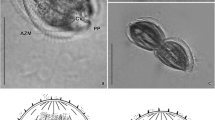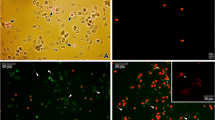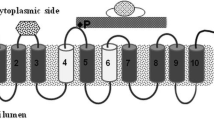Abstract.
The effect of calcium ions (Ca2+) and calmodulin (CaM) on the excystation and metacystic development of Entamoeba invadens was examined by transfer of cysts to a growth medium containing calcium antagonists and CaM inhibitors. Excystation, which was assessed by counting the number of metacystic amoebae after induction of excystation, was inhibited by the calcium chelators ethyleneglycol bis (β-aminoethyl ether)-N,N′-tetraacetate (EGTA) and ethylene-diaminetetraacetate (EDTA), with EDTA being more potent than EGTA. The inhibitory effect of higher concentrations of these chelators on excystation was associated with reduced viability of cysts. Metacystic development, when determined by the number of nuclei in an amoeba, was delayed by EGTA, because the percentage of four-nucleate amoebae was higher than in controls at day 3 of incubation. EDTA made metacystic development unusual by producing a large number of metacystic amoebae with more than ten nuclei. The inhibition of excystation by these chelators was partially abrogated by their removal. A putative antagonist of intracellular calcium flux, 8-(N,N-diethylamino) octyl-3,4,5-trimethoxybenzoate (TMB-8) also inhibited the excystation and metacystic development, but had little effect on cyst viability. The slow Na+-Ca2+ channel blocker bepridil but not verapamil inhibited the excystation and metacystic development, associating with reduced cyst viability at higher concentrations. The inhibitory effect of bepridil on excystation was abrogated by removal of the drug. The CaM inhibitor trifIuoperazine (TFP) but not W-7 [N-(6-aminohexyl)-chloro-1-naphtalene sulphonamide] inhibited the excystation and metacystic development. The inhibitory effect of TFP on excystation was also abrogated by removal of the drug. These results indicate that extracellular calcium ions, amoebic intracellular calcium flux, calcium channels, and a CaM-dependent process contribute to the excystation and metacystic development of E. invadens.
Similar content being viewed by others
Author information
Authors and Affiliations
Additional information
Electronic Publication
Rights and permissions
About this article
Cite this article
Makioka, A., Kumagai, M., Kobayashi, S. et al. Possible role of calcium ions, calcium channels and calmodulin in excystation and metacystic development of Entamoeba invadens . Parasitol Res 88, 837–843 (2002). https://doi.org/10.1007/s00436-002-0676-6
Received:
Accepted:
Issue Date:
DOI: https://doi.org/10.1007/s00436-002-0676-6




